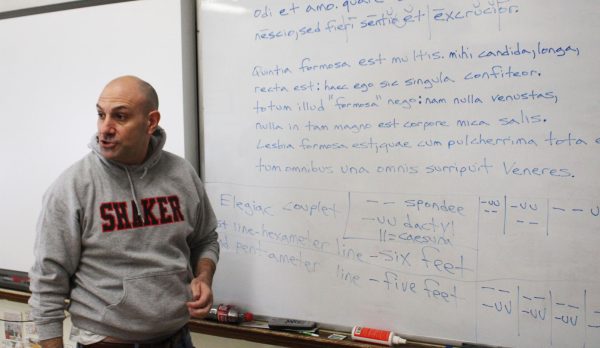New End-of-Course Exams Will Replace Ohio Graduation Test
Beginning with the class of 2020, currently sixth-graders, students will take 10 computer-administered, End-of-Course Exams to satisfy state graduation requirements instead of the tenth-grade Ohio Graduation Test, according to a plan by Ohio’s State Board of Education.
At least six of the 10 assessments will be administered in two parts: one in March, one in May.
For months, there has been “wrangling about what the graduation requirements will be and whether or not there will be an exam to replace the Ohio Graduation Test,” according to Dale Whittington, Shaker’s director of research and evaluation. As recently as Dec. 6, Whittington said, “there are some things in the pipeline, but we don’t know yet specifically what they’ll be.”
The Board of Education’s Graduation Committee devised the plan during the past summer and fall. The full Board of Education approved it in November as the official plan to replace the OGT, according to C. Todd Jones, chairman of the Graduation Committee.
In its plan, approved at a Nov. 12, 2013 meeting, the board recommends using its end-of-year exams, currently under development, to evaluate whether students are prepared to graduate. The plan specifies that high school students would take three English exams, three math exams, two science exams and two social studies exams — all of which will be provided by the state. Shaker will pilot one of the English exams, testing proficiency in English language arts 1, this April.
A coalition of 18 states and the District of Columbia called the Partnership for Assessment of Readiness for College and Careers, or PARCC, is creating the six end-of-course exams that test math and reading proficiency. Pearson Assessment, whose tests are administered in more than 70 countries, and the Educational Testing Service, which writes the SAT and Advanced Placement exams among others, develop PARCC’s exams. Using federal funding, PARCC “creates high-quality assessments that measure the full range of the Common Core State Standards,” according to its website.
Formally developed by the National Governors Association in 2009, the Common Core State Standards Initiative includes standards for mathematics and English language arts. According to the Common Core’s website, these standards “provide a consistent, clear understanding of what students are expected to learn, so teachers and parents know what they need to do to help them,” in addition to “reflecting the knowledge and skills that our young people need for success in college and careers.” In mathematics, according to the Common Core’s website, each grade level and domain of the subject has different standards. In English language arts as well, different standards exist for different categories.
The initiative “is a state-led effort . . . being driven by the needs of the states, not the federal government,” according to its website. Adoption of the Common Core standards is not mandatory, but it is tied to some federal education grants.
According to Lesley Muldoon, associate director for PARCC state engagement and policy, PARCC’s math and English end-of-course exams will be administered in two parts. A “computer-based” component will be administered in May of the course. However, a “performance-based” part will be administered first, in March.
For English exams, that March administration tests students’ writing skills through three essays. Students will write these essays by hand. Muldoon said PARCC views writing skills as necessary for “college and career readiness,” but “right now, state tests don’t include a lot of writing.” PARCC hopes increasing the writing on state tests will, in turn, improve students’ writing skills. Split into three sessions, the March component will take about three and a half hours to complete, Muldoon said.
The March portion of PARCC’s math exams will take approximately two hours. Muldoon said students will “work through several short and six to seven extended math problems that require them to use math concepts and reasoning skills to solve real-world problems and to show that they can justify their approach.”
The “performance-based” portions of the test must be administered in March because, Muldoon said, “it takes time to be able to score those types of things,” and PARCC aims to have “results back to schools by the end of the school year.”
About two hours will be required to complete the May portions of both the math and English exams, Muldoon said.
Splitting the end-of-course exams into two parts has additional benefits for students, according to Muldoon. Because each total exam score will be determined by two parts of the exam taken on two different days, PARCC expects students’ scores to suffer less from “one bad day,” Muldoon said. “You’re not just using information from one sitting [taking an exam] on one day to make decisions.”
Ohio’s science and social studies end-of-course exams are being created separately from PARCC by a different testing company. According to John Charlton, the Ohio Department of Education’s assistant director of communications, these exams will take approximately two and a half hours to complete. As of this article’s publication, Charlton did not know whether the science and social studies exams will comprise one or two portions.
Ohio’s State Board of Education does not have a timeline for how long schools will need to complete testing. However, Muldoon wrote in an email that “PARCC will offer a 20-day testing window” for its end-of-course Exams, although “states may opt to use a shorter test period within that window.” She said PARCC estimates that “most schools will be able to complete testing in as few as five to 10 days.”
According to the Board of Education’s plan, the end-of-course exams will be scored on a one-to-five scale, with five points as the highest possible score. The class of 2018, the first grade that will not take the OGT, will take five end-of-course exams during high school. Those students will have to earn a minimum of 12 points overall to graduate. The class of 2019 will have to earn at least 20 points on eight end-of-course exams. The plan estimates that all 10 exams will first be ready for students in the class of 2020, who will have to earn a minimum of 25 points to meet the graduation requirement.
However, according to Jones, only eight of the 10 finalized End-of-Course Exams will be required. “Districts have the possibility of eliminating the first math and English End-of-Course Exams,” he said. Those exams, developed by PARCC, would test proficiency in Algebra I and English language arts 1. However, “we don’t expect many districts to do that,” Jones said, because administering 10 exams instead of eight will provide more feedback to schools on their students’ academic proficiency.
Additionally, Ohio Revised Code 3301.0712 states that the “end-of-course examinations” in the new graduation requirements “shall include nationally recognized subject area assessments, such as Advanced Placement examinations, SAT subject tests, International Baccalaureate examinations, and other assessments of college and work readiness.” At this point, however, Jones said students who take AP, IB, SAT or ACT exams in a given course are not necessarily exempt from that subject’s End-of-Course Exam.
“There will be some sort of cutline, and [students] will be deemed to have passed it” based on the scores they earn on the alternative exams, Jones said. For instance, “if you complete AP Calculus and get a 3 or a 2 on the exam, that should say you have learned enough Algebra I and Algebra II to be sufficient.” However, those students “would not be exempted from taking” the End-of-Course Exams in Algebra I and II.
“That is the plan right now,” Jones said. “That is subject to change because we don’t know comparability yet” between the End-of-Course Exams and AP, IB, SAT and ACT exams. “It’s possible that your AP exam will suffice. It’s likely, but we don’t know that.”
Jones said that even if alternative assessments suffice for graduation test credits, the Board of Education expects students will want to take the state’s assessments. “There are going to be honors available based on how you do on the End-of-Course Exams,” he said. Jones mentioned a summa cum laude distinction from the state on the diplomas of students who receive 5’s on all End-of-Course Exams.
The board’s plan has met challenges. In particular, the Ohio House of Representatives passed Substitute House Bill 193 on Dec. 18. HB 193 proposes amending the Board of Education’s plan by requiring only five End-of-Course Exams to replace the OGT, pushing back that testing switch until the class of 2019, and delaying all computer-administered tests until the 2015-2016 school year.
The bill “still needs to pass the [Ohio] Senate and be approved by the governor” before its amendments go into effect, Jones said. So far, he said the Senate has been supportive of the Board of Education’s plan, while Gov. John R. Kasich has not expressed a clear opinion.
“The Ohio Department of Education was not included or involved in the drafting of HB 193,” Charlton said. However, he said the ODE provided testimony for the bill, comparing HB 193’s proposals to the graduation requirements outlined by the State Board of Education.
The ODE favored the Board of Education’s plan, testifying that “while 10 End-of-Course Exams may seem extensive, local districts will be able to substitute their local End-of-Course Exams with these state exams – ultimately decreasing the overall testing load on high school students.” The ODE added that “having 10 End-of-Course Exams, as opposed to five, would give students who are weaker in one subject area more opportunities to make up for those [weaknesses] in another area – while maintaining a minimum level of proficiency in all areas.”
The Board of Education’s plan faces another challenge in current legislation. “There is a key change that is necessary,” Jones said. “Under a budget law passed during the Strickland administration, there were some typographical errors and structural errors.”
That law, passed in 2009 as House Bill 1, “created an obligation that we continue going forward with the OGT . . . even as we administer the new testing system,” Jones said. “Unless there is a fix made legislatively . . . for the next several years, that will be the case, including when the End-of-Course Exams will begin to be used.”
“Ultimately it is not a problem that needs to be fixed — the state could administer both exams, and waste $30 million doing so,” Jones said. The money would be spent developing multiple sets of new OGT questions.
“The Ohio House [of Representatives] this year was made aware of the problem and refused to change it,” Jones said. He said he did not know why. However, he said “there will be another budget passed that could” cut out the problem.
Jones pointed out, and as the looming state-mandated testing regimen illustrates, “Political intervention can happen.”






Haven Labaki | Feb 20, 2014 at 10:53 am
With all the new requirements being put into effect already, this is just going to make it harder for kids to graduate high school. Now adding TEN new tests is a little ridiculous. That more doubles the amount of tests kids will have to take to graduate.
Dale Whittington | Jan 31, 2014 at 2:08 pm
Abby:
II finally found this!! Excellent piece of reporting